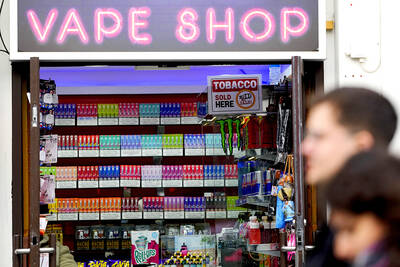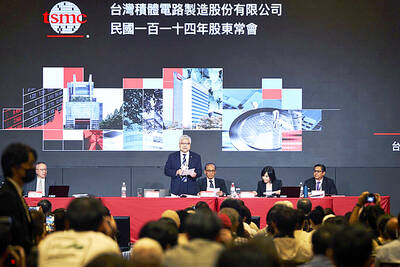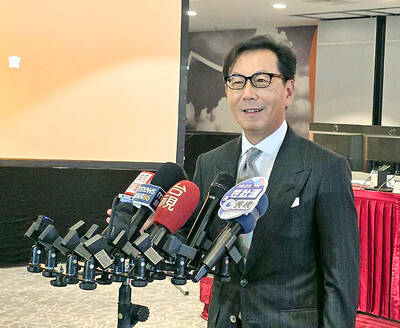Japan’s cash-bleeding electronics giants Sony Corp and Panasonic Corp are looking to join forces to produce next-generation televisions in a bid to claw back market from South Korean rivals, a report said yesterday.
The firms want to speed up the development of large-screen organic electroluminescence (OEL) televisions, which consume less power and offer a sharper picture than conventional flat panels, the Nikkei Shimbun said.
OEL is widely expected to be the dominant technology in the next generation of televisions.
Both companies are aiming to commercialize OEL TVs by fiscal 2015 and their tie-up could eventually lead to joint production, the report said, without citing sources.
The partnership would mark the first time that the two firms have joined hands in a core business, in a major turning point for the struggling Japanese electronics industry.
South Korean firms Samsung Electronics Co and LG Electronics Inc plan to release 55-inch OEL TVs this year, the Nikkei said.
Sony and Panasonic hope to devise a low-cost, high-yield manufacturing technique by bringing their technologies together, the Nikkei said.
Neither company was prepared to comment on the Nikkei report.
“The company will continue research on OEL technology based on what it has developed on its own,” Panasonic said in a statement. “Nothing has been decided at this point about research into a business plan.”
A Sony spokesman also refused to comment.
Sony and Panasonic suffered a combined US$15.4 billion loss in the year to March as falling sales and intensifying competition hit them hard.
Panasonic president Fumio Ohtsubo, who had previously announced he would step down, conceded last week that the firm’s earlier television business strategy was off the mark.
“We had invested a huge amount in 2006 and 2008 in the panel and TV businesses, but many changes occurred,” Ohtsubo told a news briefing in Tokyo.
In Tokyo yesterday, shares of Panasonic fell 3.11 percent to ¥560 and Sony was off 2.25 percent at ¥1,128, while the Nikkei 225 index at the Tokyo Stock Exchange lost 0.81 percent to 8,900.74.

CAUTIOUS RECOVERY: While the manufacturing sector returned to growth amid the US-China trade truce, firms remain wary as uncertainty clouds the outlook, the CIER said The local manufacturing sector returned to expansion last month, as the official purchasing managers’ index (PMI) rose 2.1 points to 51.0, driven by a temporary easing in US-China trade tensions, the Chung-Hua Institution for Economic Research (CIER, 中華經濟研究院) said yesterday. The PMI gauges the health of the manufacturing industry, with readings above 50 indicating expansion and those below 50 signaling contraction. “Firms are not as pessimistic as they were in April, but they remain far from optimistic,” CIER president Lien Hsien-ming (連賢明) said at a news conference. The full impact of US tariff decisions is unlikely to become clear until later this month

Popular vape brands such as Geek Bar might get more expensive in the US — if you can find them at all. Shipments of vapes from China to the US ground to a near halt last month from a year ago, official data showed, hit by US President Donald Trump’s tariffs and a crackdown on unauthorized e-cigarettes in the world’s biggest market for smoking alternatives. That includes Geek Bar, a brand of flavored vapes that is not authorized to sell in the US, but which had been widely available due to porous import controls. One retailer, who asked not to be named, because

CHIP DUTIES: TSMC said it voiced its concerns to Washington about tariffs, telling the US commerce department that it wants ‘fair treatment’ to protect its competitiveness Taiwan Semiconductor Manufacturing Co (TSMC, 台積電) yesterday reiterated robust business prospects for this year as strong artificial intelligence (AI) chip demand from Nvidia Corp and other customers would absorb the impacts of US tariffs. “The impact of tariffs would be indirect, as the custom tax is the importers’ responsibility, not the exporters,” TSMC chairman and chief executive officer C.C. Wei (魏哲家) said at the chipmaker’s annual shareholders’ meeting in Hsinchu City. TSMC’s business could be affected if people become reluctant to buy electronics due to inflated prices, Wei said. In addition, the chipmaker has voiced its concern to the US Department of Commerce

STILL LOADED: Last year’s richest person, Quanta Computer Inc chairman Barry Lam, dropped to second place despite an 8 percent increase in his wealth to US$12.6 billion Staff writer, with CNA Daniel Tsai (蔡明忠) and Richard Tsai (蔡明興), the brothers who run Fubon Group (富邦集團), topped the Forbes list of Taiwan’s 50 richest people this year, released on Wednesday in New York. The magazine said that a stronger New Taiwan dollar pushed the combined wealth of Taiwan’s 50 richest people up 13 percent, from US$174 billion to US$197 billion, with 36 of the people on the list seeing their wealth increase. That came as Taiwan’s economy grew 4.6 percent last year, its fastest pace in three years, driven by the strong performance of the semiconductor industry, the magazine said. The Tsai